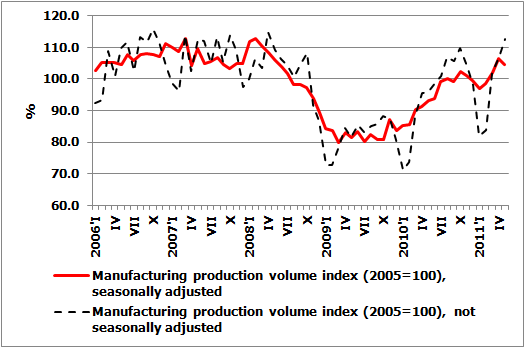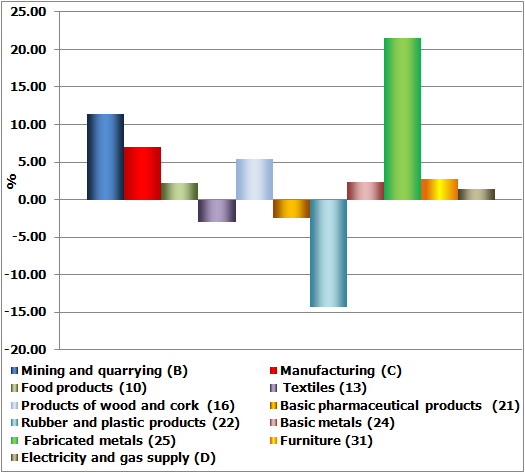In keeping with global trends, manufacturing slows in May
After a relatively rapid rise in the previous two months, the manufacturing output slowed somewhat in May. Month-on-month, manufacturing output dropped by 1.8% (excluding seasonal factors), yet maintained growth, at 12.2%, year-on-year.
Positive annual rate of growth was maintained in the production of wood products (+14.9%), readymade metal products (+38.6%), furniture production (+9.1%), production of non-metal mineral products (+31.5%), clothing production (+52.7%), as well as the production of computers, electrical and optical equipment (+9.8%). There are also several industrial branches with negative annual growth. Thus drops in output were observed in the production of food (-1.1%), beverages (-6.7%), textiles (-7.0%), chemical substances (-2.5%) as well as rubber and plastic products (-11.1%). Annual growth was maintained in mining and electrical power and gas supply – 6.4% and 3.3% respectively.
The statistics on new orders pointed to a possible drop in manufacturing output volumes as early as May. The seasonally adjusted amount of new orders has been dropping for three consecutive months (dropping in export, growing in the domestic market). In the breakdown by sub-industry, the amount of new orders has been rapidly diminishing in the production of readymade metal products yet rapidly growing in the production of chemical substances, automobiles and trailers as well as electrical equipment. In other branches, the new order statistics are fluctuating and now clear trends have emerged.
The confidence indicators compiled by the European Commission point to a deteriorating confidence in industry for three consecutive months. Over the last three months, industrial confidence has suffered an overall drop of 2.4 points. That was the result of diminished employment expectations for the next three months and an evaluation of export order amounts that match the statistics of new orders. The fact that entrepreneur outlook regarding export markets is deteriorating is in keeping with the overall status quo in the industrial sector both in Europe and the rest of the world. Over the last few months the Purchasing Managers Index or PMI has also been dropping relatively rapidly. Confidence in the Latvian industrial sector and new orders statistics follow the global industrial indicators: the Latvian manufacturing sector is integrated with the global market to a significant degree and sensitive to developments in the world raw material markets and outer demand volumes.
The development of manufacturing – especially industries oriented toward the domestic market – of course depends on local developments and conditions. In the future as well the development of manufacturing will depend on measures taken both specifically in support of the industry (e.g., tax breaks for investment projects in need of special support or education reform) or for overall economic development. In the context of next year's budget consolidation, government decisions and their timeliness will be of particular importance. It is particularly the case for those enterprises that already face a choice: invest to increase production capacities or leave that for a later date.
Fig 1. Manufacturing dynamics

Fig 2. Manufacturing annual growth rates by industry in May 2011 (calendar adjusted data)

Textual error
«… …»






